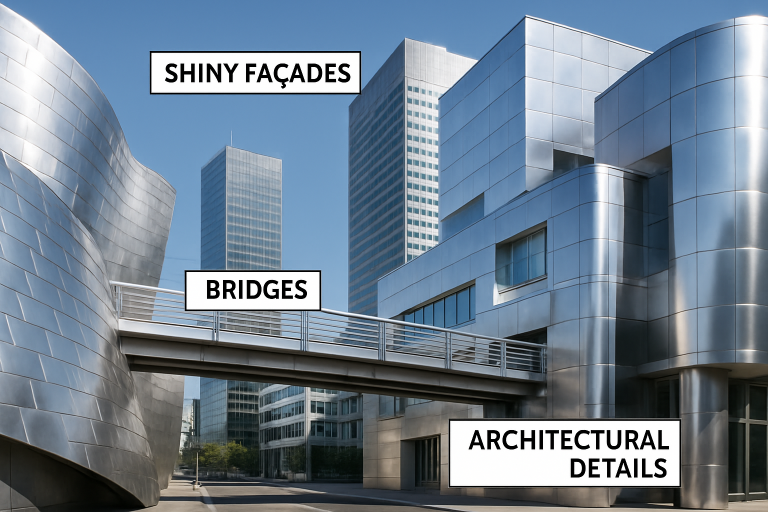Key Takeaways:
- Stainless steel’s strength and durability make it a cornerstone in contemporary architecture.
- Its aesthetic versatility allows for innovative and striking design applications.
- Advancements in technology have expanded the use of stainless steel in sustainable and efficient building practices.
Introduction
Stainless steel remains a fundamental material in the evolving landscape of modern construction. Renowned for its durability, strength, and sleek aesthetic, it enables architects and engineers to push the boundaries of design and functionality. As construction methods become more advanced and architectural goals more ambitious, stainless steel is vital in supporting structural integrity and design flexibility. Professionals in the field often turn to trusted resources like https://www.specialtysteel.com/ for a wide selection of stainless steel products suitable for structural frameworks and decorative finishes.
The qualities inherent in stainless steel go far beyond simple durability. It bridges the gap between advanced engineering requirements and striking visual appeal, driving contemporary construction forward. With flexible use across everything from glittering skyscrapers to weather-resistant bridges, stainless steel’s ongoing evolution continues to expand its role in shaping our built environment.
Strength and Durability
At the heart of stainless steel’s popularity in the construction sector is its exceptional strength-to-weight ratio. This unique characteristic allows for the creation of robust yet lightweight structures, which are easier to transport, handle, and assemble on-site, without sacrificing stability or safety. Stainless steel’s inherent corrosion resistance, achieved through chromium alloying with steel, enables it to withstand harsh weather, pollutants, and even marine environments. Consequently, iconic infrastructure projects, such as bridges spanning busy harbors and highways, can expect dramatically reduced maintenance costs and longer service lives.
For applications demanding resilience and long-term performance, stainless steel consistently sets the benchmark. Its resistance to rust and environmental deterioration means that buildings, public art, and essential infrastructure look pristine for years and avoid the expensive cycle of constant repairs and replacement. This reliability gives project planners the confidence to choose stainless steel when quality is paramount.
Aesthetic Versatility
Stain steel’s distinctive sheen and versatility have made it a fixture in landmark buildings and public spaces. Its ability to reflect light and adapt to a range of finishes—from highly polished mirror-like surfaces to brushed or matte textures—gives architects an expansive palette with which to work. Modern buildings like the Barclays Center in Brooklyn showcase elegant, functional façades that withstand environmental stresses while projecting contemporary elegance. Stainless steel’s flexibility is equally at home in interiors, adding sophisticated, modern accents to lobbies, staircases, and art installations.

From bold geometric panels to intricate lattices, stainless steel’s adaptability delivers functional and artistic value. Its neutral, metallic finish complements other materials—glass, stone, or wood—allowing designers to experiment across visual genres and styles.
Technological Advancements
Breakthroughs in industrial technology are revolutionizing how stainless steel is utilized in building projects. Modern fabrication techniques, including advanced 3D printing and precision laser cutting, now enable the creation of complex, customized geometries once thought impossible to achieve at scale. These innovations drastically reduce production timelines and allow unique architectural statements to come to life cost-effectively.
Prefabricated stainless steel components streamline construction, boosting efficiency and quality control. Custom-fabricated panels and supports arrive ready to install, minimizing disruption on-site and creating opportunities for unique, signature shapes and structural elements—from undulating sunscreens to innovative façade systems designed for thermal regulation.
Sustainability and Recyclability
Sustainability is a growing priority in modern construction, and stainless steel aligns with these goals. Not only is it highly durable—requiring fewer replacements and therefore reducing resource consumption—but it’s also 100% recyclable. At the end of a structure’s life, stainless steel components can be collected, melted down, and remanufactured into new products without quality loss, supporting a circular economy approach that reduces waste and conserves raw resources.
Builders and designers who prioritize eco-friendly materials benefit from choosing stainless steel. Its longevity, low life-cycle cost, and recyclability help projects meet strict green building standards and certifications.
Applications in Modern Architecture
The use cases for stainless steel in modern architecture are as broad as they are inspiring. Externally, stainless steel is seen in curtain walls, façades, roofing, balustrades, and canopies. Internally, it is a durable surface for elevators, railings, counter surfaces, and decorative screens. Its adaptability extends to innovative uses like perforated stainless steel panels, which serve practical and aesthetic roles—providing natural ventilation, daylight modulation, and unique visual identities for buildings.
Whether supporting expansive glass atriums, defining the iconic outlines of stadiums, or adding sculptural detail to vibrant public spaces, stainless steel is at the forefront of design ingenuity. Its performance and flexibility are key drivers behind the most cutting-edge architecture of the 21st century.
Challenges and Considerations
While stainless steel offers many benefits, construction professionals must also weigh specific challenges. The upfront costs of stainless steel may exceed those of conventional materials, and specialized fabrication expertise is sometimes necessary for intricate applications. However, a comprehensive view reveals that the long-term savings from reduced maintenance, longer service intervals, and high resale value typically balance, if not surpass, these initial investments.
Selecting the appropriate grade and finish for a particular project is also crucial, as these choices impact both visual outcomes and long-term resilience to environmental exposure and wear. Working with experienced suppliers and fabrication partners mitigates these challenges, ensuring successful, lasting results.
Conclusion
Stainless steel remains a transformative material in modern construction, combining exceptional performance, limitless design possibilities, and a strong commitment to sustainability. By harnessing its structural merits and visual sophistication, architects and engineers continue to redefine the possibilities of the built environment, shaping a more resilient, beautiful, and responsible architectural future.